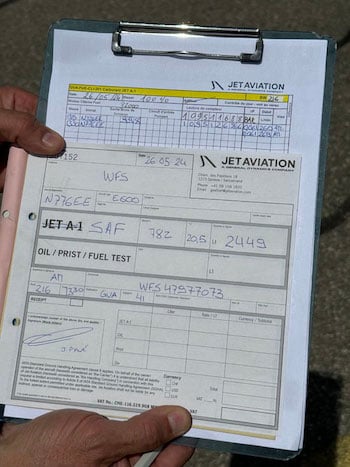
Jet Aviation is supplying SAF to Geneva Airport for EBACE. All the aircraft flying to the event, such as the Embraer Praetor 600 demonstration aircraft, are offered a 35% SAF blend.
GENEVA—It’s another year, another edition of the European Business Aviation Conference & Exhibition (EBACE), and the European business aviation community is lining up at Geneva’s Palexpo for another full slate of presentations, exhibitor briefings and sector-wide conversations about sustainability.
This focus on the sector’s environmental responsibilities would have been the case even without the unprecedented breach of airside security by around 100 environmental protesters during last year’s show. But with business aviation increasingly in the crosshairs of climate activists, the need to demonstrate tangible progress is increasing almost by the day.
Sector insiders are right, when questioned by critics, to point to the work that has already been done toward emissions reduction. Business aviation has led the way on developing and deploying more efficient engines, lighter materials, enhanced aerodynamics and advanced avionics as well as promoting the use of sustainable aviation fuel (SAF).
Yet all too often discussions about bizav sustainability at events like EBACE have had a notional or aspirational tone. OEMs highlight in-development technologies that promise step changes in emissions reduction when they eventually make it into certified production; SAF advocates continue to drum home the message to still skeptical pilots and owners that there will be no maintenance or asset-depreciation downside to consider when deciding whether or not to upload the fuel. The emphasis seems to fall on what might be possible soon, or what people in the sector might do tomorrow, rather than what is being done today.
Partly this is just a function of how any technology-centred community functions. We all appear to be hard-wired to look for what’s next, and we are slightly less excited to talk about what’s already happening. And partly sector insiders want to reinforce one anothers’ good intentions, so some degree of optimism—insistence that the problems are solvable and that solutions are coming soon—is understandable.

It is also important to remember that many of the enablers to lower-emission flying are outside the control of the business aviation industry. Policy questions are ones for governments and regulators. The slower-than-anyone-would-like adoption of SAF in the sector has more to do with limited supply and a customer base still reluctant to accept higher costs than with lack of effort on the part of operators, airports, fixed-base operators (FBO) or trade show panelists. Everyone—from fuel refiners to aircraft OEMs—is looking for funding; and while institutional investors seek mature projects with guaranteed returns, venture capitalists want to hear about novel ideas and futuristic vehicle concepts.
But enthusiasm for what is coming in a few years and excitement about electric air taxis and other new concepts will do little to win the public perception battle into which business aviation finds itself reluctantly drawn. If the sector seems to be pinning its hopes on unproven technologies coming to the rescue by 2050, its public relations problems may only just be beginning.
This year’s EBACE conference program gives some cautious grounds for optimism. The main session devoted to SAF, for instance, is billed as a case study—so those who head to the Innovation Stage at 10 a.m. on Wednesday will hopefully be able to hear about how operators, FBOs and fuel providers are working together to increase supplies of the fuel today and what they are doing to encourage customers to buy it and pilots to uplift it. Later the same day, attendees at the Conference Stage will hear about best practices for reducing greenhouse gas emissions—things that can be done with current flight planning and air traffic control technologies to limit the harm today’s operations are causing to the environment.
Across the sector, companies and individuals are doing whatever they can to make a difference. Saxon Air, based in Norwich, England, has been flying a Pipistrel Velis Electro at its own expense to learn about the challenges of operating battery-electric aircraft and is capitalizing on emerging interest by opening a low-emissions flying school. Oxford Airport has poured SAF into its fuel farm so every aircraft refuelling there will upload some of it, whether they pay the extra to get the carbon certificate or not. Martyn Fiddler Aviation has used its state-of-the-industry report to reflect opinions widely held but rarely heard, that business aviation sustainabilityconversations are too often about what people want to be seen to be saying, not what they actually think.
These examples are by no means the result of an extensive survey: They have been chosen from the very short list of stories covered by this writer in the past month and are a limited sample of a far larger number of innovative initiatives being pursued by people and businesses across the sector. None of these actions will have been easy—some cost nontrivial sums of money, and each carries an element of risk. But all of them are things people in business aviation can do today. They might be small steps, but they are happening now, and they need to be talked about every bit as loudly as the giant leaps everyone hopes will be coming soon.
